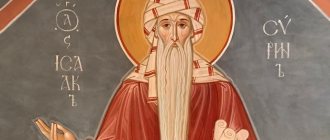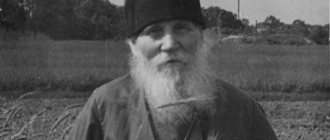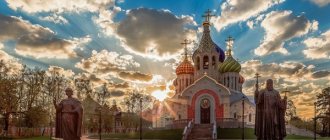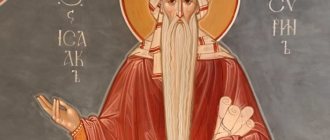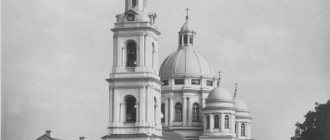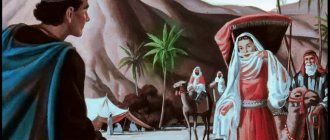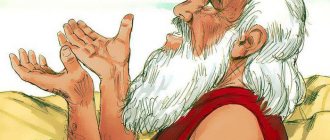Information about the origin of St. Isaac the Syrian
Little is known about the exact details of the life and ascetic activity of St. Isaac the Syrian. Biographical information that has come down to us from early centuries varies in detail.
Knowledge regarding this important pathological issue was for a long time so limited that until the 18th century the Monk Isaac was often identified with different people: sometimes with Isaac, a poet and polemicist of the 5th century, a famous Antioch presbyter; then with Isaac, who was fleeing in Italy (mentioned in the works of St. Gregory the Dvoeslov); sometimes with the Bishop of Nineveh, sometimes with a completely unknown person.
More or less reliable data became available to a wide range of Church historians with the discovery and publication of an Arabic biography of this saint. The author of the named biographical source was content with brief information and did not provide accurate detailed facts about the birth and life of the monk. Nevertheless, this source revealed a number of important data that opened up the possibility of more clearly identifying the identity of Saint Isaac. In 1896, through the efforts of the French researcher Chabot, the work of the Syrian historian of the 8th century, Jezudena, gained fame, in which, among other things, he set out the story of Mar-Isaac.
From a general comparison of the historical monuments available today, the picture of the life of Isaac the Syrian develops as follows. He lived approximately in the VI-VII centuries. According to some sources, he came from Beth-Katarayya, and according to others, his birthplace was the city of Nineveh, an ancient cultural, political and economic center.
Even in his youth, Isaac and his brother entered the monastery of Mar Matthew. Both of them stood out among the inhabitants of the monastery for the height of their exploits and learning. As a result, Isaac's brother was awarded leadership of the monastery. Isaac himself, having chosen the path of prayerful solitude and silence, retired to a hermit’s cell.
History of the life of the saint
Very little information has been preserved about Saint Isaac the Syrian, which is why he was long mistaken for Isaac of Antioch. In fact, these are two different people.
Young monk
There is no exact information about the place and date of birth of the great ascetic. The year of his departure to the Lord is also unknown. Presumably he lived in the 6th-7th centuries in Syria and Assyria.
Reverend Isaac the Syrian is one of the deeply revered fathers of the church
He arrived at the monastery of Mar-Matthew from Nineveh or Beth-Katarayya and took monastic vows together with his brother. Both of them stood out for their spiritual talents among the brethren of the monastery. The Monk Isaac's brother was elected abbot, and he himself chose the path of hermithood. The Holy Father tried in every possible way to avoid human fame and glory and did not leave the desert despite his brother’s requests to return.
Bishop and his flock
Residents of the city of Nineveh learned about the ascetic and his great spiritual gifts from the Lord. They earnestly asked their father to be their archpastor. Saint Isaac, considering obedience one of the most important and most important virtues, humbly agreed. His ordination was carried out by Patriarch George. So the monk became the Bishop of Nineveh.
Having ascended the episcopal throne, the ascetic showed every concern for the flock entrusted to him. The Holy Father was not interested in fame and honors; what was important to him was the salvation of people. But in less than six months, the bishop became convinced that the inhabitants of Nineveh were leading a lifestyle that was contrary to the Holy Gospel and did not want to change their usual way of life.
So, one person owed a large sum, but had no way to repay the debt. He asked the lender for a deferment and addressed his problem to Bishop Isaac. The monk tried to put grains of Holy Scripture into the lender’s heart, instructing him in a Christian attitude towards his neighbors. He pointed to the words from the Gospel that speak of forgiveness of all debt to a person who has nothing to pay and is in a difficult situation. But the rich lender directly stated that living according to the Gospel is inconvenient and unprofitable; besides, there are more important and interesting things.
A number of similar situations convinced the bishop that the Ninevites did not want to improve and he was beyond his power to change them. According to historians, added to this was the fact that there were many heretics in the city - Monophysites. The ascetic cared for the purity of Orthodoxy and was not a supporter of empty disputes and meaningless conversations about dogma. As a result, he returned to the hermit's life again.
Last years
The monk carried on the feat of hermitage until his death. Details about the life of the ascetic are unknown. The testimonies of his disciples have been preserved, who said that the monk loved to read the Holy Scriptures, and from these works and much crying, Father Isaac lost his sight. Therefore, the novices even called him “the second Didymus,” meaning Didymus the Blind, the great theologian of the 4th century.
The works of the ascetic in the last years of his earthly life were recorded under dictation by his students. Presumably the monk completed his earthly labors in the 7th century.
Isaac with his brother in the monastery
Appointment of a hermit as Bishop of Nineveh
Ascetic life in recent years
Ascetic life
His brother repeatedly sent him letters, urging him to return to the monastery. But he, without doubting the correctness of his meaningful choice, continued his hermit life. As justification for this decision, the monk emphasized the need to concentrate on prayer and contemplation of God, and the fight against scattered thoughts and wandering of the mind (cf. Homily 24).
Over time, the fame of the holiness of Isaac's life spread so much that the people of Nineveh began to ask and insist on his consecration as Bishop of Nineveh. The monk did not reject the will of the people and, relying on God’s Providence, accepted the dignity of bishop. They say that Patriarch George ordained him a bishop in the Beth-Abe monastery.
Meanwhile, not all local residents, due to the depravity of their morals, were ready to listen to him as their shepherd. And one incident completely infuriated the monk. A certain creditor could not collect the debt from his debtor in a timely manner and threatened to transfer it into the hands of a judge; and he, in turn, not being able to pay immediately, asked for a deferment. When they brought the problem to the court of Father Isaac, he reminded the lender that, according to the Gospel, even complete forgiveness of debts, and even more so, their deferment, may be appropriate. In response, the disgruntled lender became angry and made it clear that since the Gospel did not meet his current material interests, it was not an absolute authority for him.
So, the disobedience of his flock led to the fact that after approximately five months of governing the diocese, Saint Isaac renounced the post of bishop and retired from the world: according to some sources, to the monastery hermitage in Egypt, and according to others, to Mount Matu, in the area of Beth-Guzaya (region , lying north of the coast of the Persian Gulf), after which, after living there for some time, he moved to the monastery of Rabban Shabur.
During this period, Saint Isaac was engaged in the ascetic practice traditional for monastic ascetics, spending his life in work, prayer, vigils and fasting. There is a legend that he did not touch boiled food at all, ate three loaves of bread a week, supplementing this meager diet with only a small amount of grass.
Living the life of a hermit, the saint paid great attention to reading and studying the Holy Scriptures. At the same time, he was engaged in writing. According to legend, as a result of intense reading, and, of course, due to extreme exhaustion from ascetic deeds, he lost his sight. But even after this he did not stop engaging in literary work: during this period, his speeches were recorded by monastic scribes.
By the providence of God, the saint lived a long life and rested in the Lord in old age. He died in the Shabur monastery.
About Abba Isaac St. Joseph the Hesychast said this: “If all the writings of the holy desert fathers on sobriety and prayer were lost and only the ascetic words of Abba Isaac were preserved, they would be enough to teach a person a life of silence and prayer from beginning to end. These creations reveal the ascetic life from A to Z, and they alone are enough to instruct a person from the first steps and lead him to perfection.”
Brief history of the life of the saint
Little is known about the details of the life of this saint; various biographical data about his activities differ in detail. Until the 18th century, St. Isaac of Nineveh was often identified with other historical figures. The great Christian theologian was confused either with his namesake, who was engaged in polemics in the 5th century, or with a man who was fleeing persecution in Italy.
Venerable Isaac the Syrian, Bishop of Nineveh
Everyday facts about the venerable ascetic Isaac, claiming to be authentic, became known to society with the discovery of his biography in Arabic. However, the author of the biography used brief information in his work and did not give precise details about the birth and existence of Sirin.
Despite the paucity of facts, the source became for the Christian world the specimen that made it possible to identify the personality of the venerable ascetic in more detail.
- Isaac was born in the 6th century in the famous city of Nineveh, the capital of the Assyrian kingdom (modern Iraq). Even in his youth, he and his brother settled in the ancient monastery of Mar Matthaya, located on the peak of Mount Alfaf. The newly arrived inhabitants were distinguished by their ability to learn and their strength to cope with ascetic exercises for body and spirit. Brother Sirin was soon awarded the rank of abbot of the monastery, and Isaac decided to retire to a hermit’s cave in order to indulge in prayerful confession and silence.
- Saint Sirin did not doubt the truth of his choice, despite the fact that his relative sent him letters asking him to return to the monastery. Isaac answered: the path of asceticism is correct, since it allows you to concentrate on thoughts about God without interference, and also helps to get rid of unnecessary hesitation of a wandering mind.
- After a while, even people from the outskirts of the Assyrian state learned about the great hermit’s feat. The respected saints asked Isaac the Syrian to accept the position of Bishop of Nineveh. The venerable ascetic did not resist the will of the people and the priesthood; he relied on providence and accepted the rank of bishop. The ordination ritual was performed by Patriarch George.
The creative legacy of St. Isaac, mentor of monks and church writer
We do not know the exact number of works compiled by the monk. But even those that have been discovered today reveal in him a well-educated, spiritually mature ascetic, a very prolific author (see: Ascetic Words).
The range of questions raised by Saint Isaac throughout his literary career is extremely broad. His focus was on numerous exhortations to the monastics; instructions related to the disclosure of dogmatic truths; personal psychological observations; and the experience of encounters with God. So we can say: despite the ascetic nature of his writings, in general they are addressed to a wide range of people.
A characteristic feature of the work of St. Isaac as a spiritual writer is a clear connection between doctrinal edifications and their practical application to life.
Thus, when discussing God, he does not forget to indicate what is the benefit of constant contemplation of God (see: Homily 8.), and draws moral parallels between Divine properties and Christian virtues. Talking about angels, he reveals their role in the formation and spiritual and moral improvement of the individual, and talking about demons, he reveals the means they use in the framework of invisible warfare, clarifies what their cunning and cunning consist of (see: Word 60.).
The saint set the acquisition of dispassion as one of the most important tasks in achieving the highest perfection. True dispassion, he emphasized, does not consist in not feeling the movement of passions within oneself, but in making them alien to a Christian, in not accepting them under any circumstances.
The saint paid special attention to the fact that one cannot treat without due attention even those types of sins that are considered minor among sinners. Such a person will inevitably fall into more serious sins and receive more terrible punishment (see: Word 57.).
Author's books:
Venerable Isaac the Syrian
About divine mysteries and spiritual life
I am writing this out of my ardent love for you, which is such that even...
Venerable Isaac the Syrian
Ascetic instructions
The fear of God is the beginning of virtue; it is a product of faith and is sown...
Venerable Isaac the Syrian
Ascetic words
The fear of God is the beginning of virtue. It is called generation...
